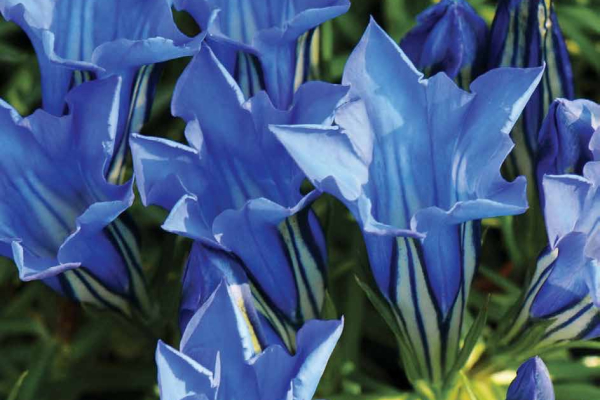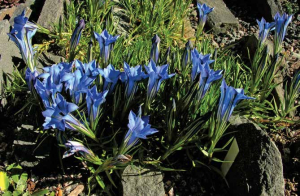There is no doubt that the mid-spring to early summer months are the time when rock gardens are at their glory. After all, most rock gardens in north temperate regions feature alpines, plants that hail from high mountain regions where the growing season is short and plants have to bloom early to have time to set seed before the fall snows start. From mid-summer we rely heavily on foliage of the alpines to carry the display through until autumn. By September, if we want to have colour in the rockery, we rely primarily on
the fall-flowering bulbs – Crocus, Colchicum and Cyclamen. However, there is one group of alpines that naturally bloom in September, October and even into November. Not only do they flower in fall, but their colour is spectacular, reflecting the intense blue of the autumn sky. Say hello to the Chinese autumn- flowering gentians!
We have the plant explorers of the early 20th century to thank for the introduction of these spectacular gentians. While many European gentians have been cultivated for hundreds of years, the Asian species have only been known in cultivation for the last 100 years. The first to be discovered was perhaps the most important species: Gentiana sino-ornata, discovered in 1904 by the consummate Chinese plant explorer George Forrest. Ernest Wilson discovered G. veitchiorum the following year. Not to be outdone, Reginald Farrer and William Purdom discovered G. farreri in 1914.
Taxonomically, most of the stars among the Chinese autumn- flowering gentians belong to Gentiana section Kudoa (aka Frigida or Monopodiae). Fritz Kohlein (Gentians, 1991) lists 15 species of gentians that belong to this section, and the Flora of China lists 30 species, but only around 7 or 8 of these are cultivated to any degree. In fact, it is the hybrids derived from this section that are more popular in cultivation.
In the wild, the species hail from peaty alpine meadows at an altitude of 2500 m to 4800 m (8200–15750 feet). Many of the best species are Sino-Himalayan, found in the southwestern Chinese provinces of Yunnan, Sichuan and Gansu. Plants produce many decumbent (trailing) stems, up to 20 cm (8 inches) long arising from a central tuft. Plants are not tap-rooted, thus transplanting is relatively easy. Their leaves are narrow, almost grass-like, produced along the stem that terminates in a relatively large solitary flower. The flower is tubular to funnel-shaped, with five corolla lobes (fused petals) and five similar but smaller
plicae located between, imparting the impression of a 10-pointed star. Floral colour ranges from white through shades of pure blue to nearly purple. The reverse of the floral tube is attractively striped in deep blue. Flowers open fully on sunny days but remain closed during cloudy, wet conditions.
In cultivation, some of the species are difficult while others are easy. The challenge to cultivating these outstanding gentians is providing them with full sun, cool, moist soil that is highly acidic, and high atmospheric humidity. Not an easy task for most North American growers! It is not surprising that the Scottish growers seem to have the best success. Of course, they also have the best success with Meconopsis, Cremanthodium, and Himalayan Primula which grow side-by-side with these gentians. I am fortunate that the climate where I work, at the Memorial University of Newfoundland Botanical Garden in St. John’s, although a little warmer in summer than Scotland, still has the necessary conditions that seem to keep these gentians reasonably happy. If by chance you have all the required growing conditions but your soil is more alkaline, fear not – Gentiana farreri is reasonably lime-tolerant, well, less intolerant at least.
So, which are the species and hybrids one can choose from? Gentiana sino-ornata is by far the most often encountered and while easy to grow in the right spot, it detests even the slightest trace of lime. It
can produces additional plants where their stems touch the ground, allowing them to produce significantly sized mats in due time. Their azure-blue funnel- shaped flowers are among the largest of the section, up to 6.5 cm long. Their blooming season stretches from September in warmer areas to November in cooler. I have even picked a few flowers for the table in mid-December! Gentiana ornata is similar but more compact with smaller flowers, 3.5 to 4 cm (about 1.5 inches) long, that are more bell shaped. It also blooms earlier in August and September. Gentiana farreri is perhaps second to G. sino-ornata in popularity. It has a similar habit to G. sino-ornata but its flowers are described as “Cambridge” blue with a contrasting white throat, creating a lovely bi-coloured effect. This species, as previously noted, is the only one that will tolerate some lime. Gentiana prolata, rare in cultivation, is recognized by the fact that its corolla lobes are held more erect rather than spreading wide. Gentiana veitchiorum is quite distinct within this section. Plants are quite compact with thicker, broader, fleshier leaves that are more blunt-tipped than the others. It has branching stems as well. The flowers are very dark purple-blue and the exterior stripes on the corolla tube are more yellow than white. Very striking in bud as well as in bloom. While Kohlein states it blooms August-September, in my garden, it does not bloom until late October and through November, making it the last alpine to grace my crevice garden. Frost and even early snow do not seem to bother it.
The one species I want to try is G. hexaphylla. It blooms in August, so is not particularly a fall-bloomer. It has pale blue flowers with six corolla lobes and six plicae, resulting in a 12-pointed star. Its leaves are grouped in whorls along the flowering stems.
The last species of this section you are likely to encounter is Gentiana georgei. This is another species that was discovered by Forrest. It is also a distinct species and not really fall-blooming, rather mid- to late summer, from late July through mid-September. It has a growth habit similar to G. veitchiorum but is larger in all parts. Its fleshy leaves are the largest of the section, reaching up to 6.5 cm in length. The flower stems are stiffer and held more erect than the other species. The 5 cm (2 inch) long flowers are variable in colour from mid-blue to rich purple-blue. I fell in love with this species when I first saw it in the garden of Stephanie Ferguson, in Calgary, Alberta. It might also be somewhat lime-tolerant based on the fact that Calgary naturally has quite alkaline soil.
Hybrids derived from this section are, on the whole, more popular than the species, easier to grow, and often more easily obtained. Through many years of selection, some splendid shades of blue and two-tone blue and white have been developed, and the flowers are often larger than any of the species. Pretty much all of the hybrids (close to 100) are desirable, some highly so. We have Jack Drake, of Inshriach Nursery, Scotland, to thank for many of the older hybrids, predominantly hybrids between G. sino-ornata and G. farreri. Noteworthy are ‘Alpha’, Drake’s Strain’, ‘Inverleith’, and ‘Kingfisher’. One of my favourites, based solely on images I’ve seen, is the German hybrid ‘Delft’. The white flowers with blue-tipped corolla lobes are positively exquisite. If only I could track it down.
More recently Ian McNaughton, of Macplants Berrybank Nursery in Scotland, has introduced some outstanding cultivars including ‘Braemar‘, ‘The Caley’, ‘Glamis’ and a series of hybrid gentians such as ‘Berrybank Star’, named after the nursery.
The fall-blooming gentians are not all restricted to the section Kudoa. There are other miscellaneous Himalayan species of gentians, mostly from the section Pneumonanthe, that naturally do not bloom until late August and through September, and even October in northern areas such as where I live.
Gentiana scabra, from Japan and northern Asia, is a bushy, somewhat upright species with several leafy stems to 30 cm (12 inches). The paired leaves are ovate with rough margins. The flowers are produced in a dense terminal raceme with four or five 2.5 cm (1 inch) long bell- shaped flowers. The corolla lobes are somewhat rounded while the plicae are pointed. The flowers are mid-blue with copious green spotting.There are two named cultivars well worth seeking out. ‘Hakuju’ has white corolla lobes and contrasting blue plicae creating a stunning striped effect. ‘Zuikorindo’ is unique in having deep pink flowers.
Another similar species in the same section is G. septemfida, this time from the Caucasus and western Central Asia, which has flowers similar to those of G. scabra but on trailing rather than upright stems. Gentiana pneumo- nanthe, the European marsh gentian, is in fact a Eurasian species found from western Europe to Siberia. In cultivation it tends to be fairly short-lived but it can be maintained in a wet situation for some years or renewed from seed.
Gentiana cachemirica produces a cluster of semi-erect stems to 15 cm (6 inches). The ovate leaves are paired and stemless. Each stem ends in one to three, bell-shaped flowers that are about 2.5 cm (1 inch) long and a clear azure-blue. It comes from the western Himalaya. Plants sold as G. loderi are now considered conspecific with G. cachemerica.
Gentiana paradoxa is not a Chinese species, rather it is an endemic of the Caucasus, but it is allied to section Pneumomanthe. Blooming may be as early as August in southern areas but in Newfoundland, mine does not start to bloom until October and extends well into November. This lime-loving species is very distinct with its bright green, narrow leaves and upright stems 20-30 cm (8–12 inches) tall. It has relatively large, solitary flowers that are mid-blue with fringed plicae and a few green spots. The throat is striped white and spotted deep blue. Beware when you grow this species from seed; you have a good chance of ending up with a hybrid between it and G. septemfida.
Gentiana boissieri, another in the section, is a newly discovered species from Turkey. It has leafy, prostrate stems to 15 cm (6 inch) with relatively small, rounded leaves. Like many of these late-flowering species, the stems terminate in a large solitary mid-blue flower. The corolla lobes are rather rounded. It is another lime lover. The blooming season is variable, with plants blooming in August in warmer areas, but not until September in cooler ones.
Section Cruciatae (aka Aperta) is named after Gentiana cruciata, a species that is happy in a limy soil. This species, not the most dramatic from a garden perspective, has a range from Europe through the Caucasus and Iran as far as Siberia. It typically flowers in summer. Gentiana kurroo is the one late-blooming species from the section Cruciata (aka Aperta). Plants produce a rosette of linear to lance-shaped leaves up to 10 cm (4 inches) long. From the rosette arise several slightly ascending stems to 15 cm (6 inches), each topped with a solitary, relatively large blue flower with green spots. Alas, most of the seeds offered as G. kurroo are misidentified. I have tried this one from seed for many years and have yet to get the real thing. I have ended up with G. dahurica, G. macrophylla, G. gracilipes, G. dendrologii, G. wutaiensis and G. crassicaulis! On the plus side, I have incidentally increased the gentian collection at our botanical garden.
While our rock gardens are no doubt the most spectacular in spring and early summer, the approach of autumn need not mean the end of the rockery display.
As you can see, there are plenty of late-blooming gentians that can help extend the blooming season. I hope this article encourages you to seek out some of these very desirable plants. Any plant that literally can be in bloom until the fall of the first flakes of snow has to be a good thing !


